Dow Theory Explained: Ocean Tides and Stock Markets
On January 31st,1901 Charles H. Dow compared the stock market to the tides of the ocean when he wrote in the Wall Street Journal “A person watching the tide coming in and who wishes to know the exact spot which marks the high tide, sets a stick in the sand at the points reached by the incoming waves until the stick reaches a position where the waves do not come up to it, and finally recede enough to show that the tide has turned. This method holds good in watching and determining the flood tide of the stock market.”
If you think of the Dow Jones Industrial Average as being the measure of the tide on one part of the beach, and the Dow Jones Transportation Average as a measure on another part of the beach, both used to determine that the tide is indeed coming in or going out all along the seashore, rather than rogue waves in one place or the other, you will understand what Dow was getting at. Confirmation by both is an integral part of the Dow Theory.
The “few hypotheses”:
- Manipulation is possible day-to-day but the primary trend cannot be manipulated.
- The Averages discount everything (except acts of God).
- The theory is not infallible.
The “definite theorems”:
- There are three movements of the averages. The first, and most important, is the primary trend. The second, and most deceptive is the secondary reaction. The third, and usually unimportant, is the daily movement.
- Both the Industrial and Transportation averages must confirm a trend.
- The determination of a major trend has come to be known as a signal to Buy or Sell, although Dow never called them such.
The classic Buy signal is developed as follows: After the low point of a primary downtrend in a Bear market is established, a secondary uptrend (this is the most often debated part of the Theory) bounce will occur. After that, a pullback on one of the averages must exceed 3%, according to Robert Rhea in his 1930’s The Dow Theory, must then, ideally, hold above the prior lows on both the Industrial and the Transportation Averages. Finally, a breakout above the previous rally high by both, constitutes a BUY Signal for the developing Bull market.
The chart represents how the Dow Jones Industrial Average and the Transportation Average might look under the most usual BUY signal (B-1):
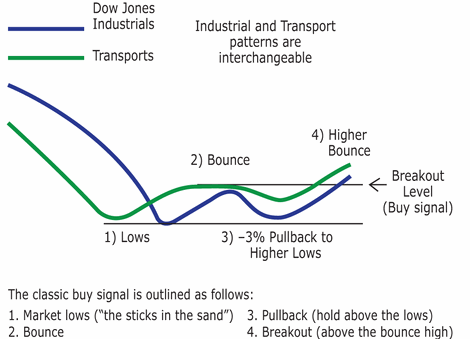
More than one bounce can occur within the confines of the bounce highs and the lows. Any such non-confirmation by the other Average is inconsequential.
While neither the primary nor the secondary trends have been specifically defined, my own research shows that a Bull market primary trend will have advanced in excess of 19% on both the Dow Jones and Standard & Poor’s 500 Indices. A Bear market primary trend will have declined in excess of 16% on both.
A review of the Dow Theory signals implies that a secondary trend will usually bounce at least 4% on both the Industrials and Transportation Indices, and usually one or both will exceed 7%. According to The Dow Theory, by Robert Rhea, secondary reactions “usually last from three weeks to as many months, during which…the price movement generally retraces from 33 per cent to 66 per cent of the primary price change..” In the same book, Dow’s successor, William Peter Hamilton, described “secondary reactions…(as) lasting from a few days to many weeks“.
What is precisely defined is the extent of the “return move”, the pullback after a bounce up from a Bear market bottom, or the bounce after a pullback from a Bull market top, and that shall exceed 3% on either of the averages.
A Bear market Sell signal is determined in much the same way, but opposite to a Buy Signal. When a Bull market tops and sets back, and the subsequent rally that goes back up (again, over 3%) and falls short of reaching the previous high and then penetrates the recent lows on the next decline as measured by both the Industrial and Transportation Averages, a SELL Signal is generated indicating a Bear market. This is the must usual SELL signal (S-1):
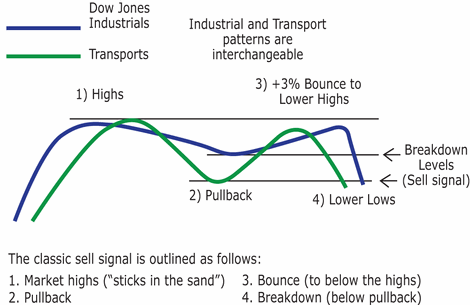
Other acceptable patterns are as follows:
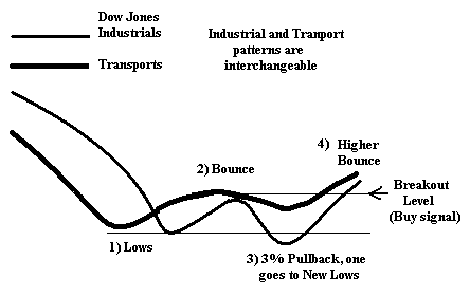
BUY (B-2) shown above
1. Market Lows
2. Bounce
3. Pullback (one index makes a new low)
4. Break up
SELL (S-2) shown below
1. Market Highs
2. Pullback
3. Bounce (one makes a new high)
4. Break down
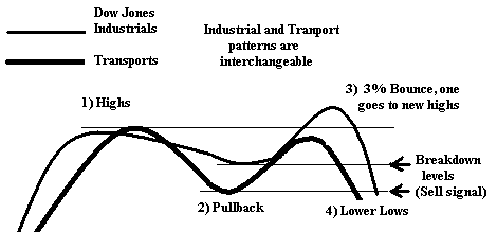
BUY (B-3) shown below
1. Market Lows
2. Bounce
3. Pullback
4. Break up (one only)
5. Pullback (other makes lower low)
6. Break up (over both bounce highs)
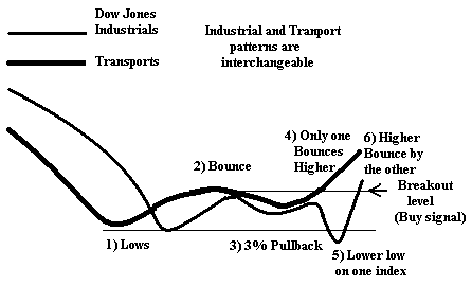
SELL (S-3) shown below
1. Market Highs
2. Pullback
3. Bounce (one makes a new high)
4. Pullback (other makes a new low)
5. Bounce (first makes a newer high)
6. Break down (below both pullback)
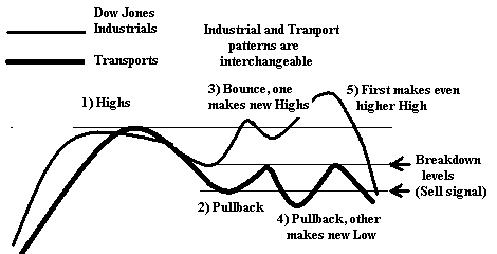
BUY (B-4) shown below
1. Market Low
2. Bounce
3. Pullback (one may go to new low)
4. Lower bounce (on one or both)
5. Lower pullback (another new low)
6. Break up (over first bounces)
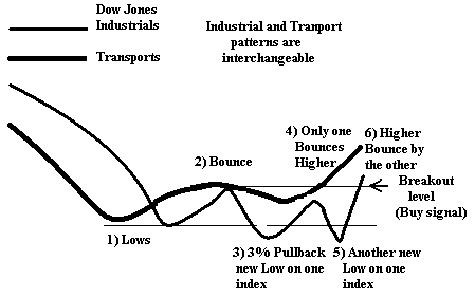
BUY (B-5)
1. Market Low
2. Bounce
3. Pullback
4. New all-time highs on both
Other combinations of the above can occur with non-confirmations (divergence) at various points and still qualify as “signals”. New all-time highs negate the need for pullbacks to confirm a new Buy.
The following record is for the original Dow Theory discussed above. Since the Dow Theory was first developed in the early 1900s, I have added to its usefulness; that evolution, interpretation, and subsequent record as outlined in my book “Dow Theory for the 21st Century“, is available for Subscribers only, along with the current status.
| Signal: | Date: | Results: | Dow Jones Level |
|---|---|---|---|
| 12/31/1953 | 280.90 | ||
| BUY | 1/19/1954 | 288.27 | |
| 12/31/1954 | 404.39 | ||
| 12/30/1955 | 488.40 | ||
| SELL | 10/1/1956 | 468.70 | |
| 12/31/1956 | $18,388 | 499.47 | |
| 12/31/1957 | $18,967 | 435.69 | |
| BUY | 5/2/1958 | $19,059 | 459.56 |
| 12/31/1958 | $24,826 | 583.65 | |
| 12/31/1959 | $29,763 | 679.36 | |
| SELL | 3/3/1960 | $26,967 | 612.05 |
| 12/30/1960 | $27,548 | 615.89 | |
| BUY | 2/23/1961 | $27,642 | 654.42 |
| 12/29/1961 | $31,653 | 731.14 | |
| SELL | 4/26/1962 | $29,694 | 678.68 |
| BUY | 11/9/1962 | $30,130 | 616.13 |
| 12/31/1962 | $32,052 | 652.10 | |
| 12/31/1963 | $38,695 | 762.95 | |
| 12/31/1964 | $45,749 | 874.13 | |
| 12/31/1965 | $52,366 | 969.26 | |
| SELL | 5/5/1966 | $49,133 | 899.77 |
| 12/30/1966 | $50,684 | 785.69 | |
| BUY | 1/11/1967 | $50,751 | 822.49 |
| SELL | 10/24/1967 | $56,279 | 888.18 |
| 12/29/1967 | $56,745 | 905.11 | |
| BUY | 10/1/1968 | $58,909 | 942.32 |
| 12/31/1968 | $59,472 | 943.75 | |
| SELL | 2/25/1969 | $56,992 | 899.80 |
| BUY | 10/27/1969 | $59,396 | 860.28 |
| 12/31/1969 | $55,674 | 800.36 | |
| SELL | 1/26/1970 | $53,639 | 768.88 |
| BUY | 9/28/1970 | $55,943 | 758.97 |
| 12/31/1970 | $62,421 | 838.92 | |
| SELL | 7/28/1971 | $66,149 | 872.01 |
| 12/31/1971 | $67,389 | 890.20 | |
| BUY | 2/10/1972 | $67,635 | 921.28 |
| 12/29/1972 | $76,977 | 1020.02 | |
| SELL | 2/23/1973 | $72,811 | 959.89 |
| 12/31/1973 | $77,130 | 850.86 | |
| 12/31/1974 | $82,927 | 616.24 | |
| BUY | 1/27/1975 | $83,250 | 692.66 |
| 12/31/1975 | $106,781 | 852.41 | |
| 12/31/1976 | $130,597 | 1004.65 | |
| SELL | 10/24/1977 | $108,392 | 802.32 |
| 12/30/1977 | $109,553 | 831.17 | |
| BUY | 6/6/1978 | $112,441 | 866.51 |
| 12/29/1978 | $107,648 | 805.01 | |
| 12/31/1979 | $118,484 | 838.74 | |
| 12/31/1980 | $143,938 | 963.99 | |
| SELL | 7/2/1981 | $147,084 | 959.19 |
| 12/31/1981 | $156,080 | 875.00 | |
| BUY | 10/7/1982 | $168,791 | 965.97 |
| 12/31/1982 | $185,407 | 1046.54 | |
| 12/30/1983 | $233,055 | 1258.64 | |
| SELL | 1/25/1984 | $228,800 | 1231.89 |
| BUY | 11/6/1984 | $245,165 | 1244.15 |
| 12/31/1984 | $240,431 | 1211.57 | |
| 12/31/1985 | $320,238 | 1546.67 | |
| 12/31/1986 | $406,367 | 1895.95 | |
| SELL | 10/15/1987 | $515,904 | 2355.09 |
| 12/31/1987 | $522,011 | 1938.83 | |
| BUY | 2/29/1988 | $526,632 | 2071.62 |
| 12/30/1988 | $567,712 | 2168.57 | |
| SELL | 10/13/1989 | $690,657 | 2569.26 |
| 12/29/1989 | $701,196 | 2753.20 | |
| BUY | 6/4/1990 | $723,170 | 2935.19 |
| SELL | 8/3/1990 | $696,567 | 2809.65 |
| 12/31/1990 | $716,053 | 2633.66 | |
| BUY | 1/18/1991 | $717,964 | 2646.78 |
| 12/31/1991 | $885,154 | 3168.83 | |
| SELL | 10/5/1992 | $907,290 | 3179.00 |
| BUY | 11/25/1992 | $911,084 | 3266.22 |
| 12/31/1992 | $923,621 | 3301.11 | |
| 12/31/1993 | $1,079,925 | 3754.09 | |
| 12/30/1994 | $1,131,774 | 3834.44 | |
| 12/29/1995 | $1,545,971 | 5117.12 | |
| 12/31/1996 | $1,988,782 | 6448.27 | |
| 12/31/1997 | $2,479,930 | 7908.25 | |
| SELL | 8/4/1998 | $2,686,917 | 8487.31 |
| BUY | 11/2/1998 | $2,716,142 | 8706.50 |
| 12/31/1998 | $2,872,309 | 9181.43 | |
| SELL | 9/23/1999 | $3,265,010 | 10318.59 |
| 12/31/1999 | $3,307,401 | 11497.12 | |
| 12/29/2000 | $3,492,515 | 10786.85 | |
| BUY | 11/8/2001 | $3,598,452 | 9587.52 |
| 12/31/2001 | $3,771,855 | 10021.50 | |
| SELL | 6/25/2002 | $3,465,768 | 9126.80 |
| 12/31/2002 | $3,491,963 | 8341.63 | |
| BUY | 1/6/2003 | $3,492,510 | 8773.57 |
| 12/31/2003 | $4,250,430 | 10453.92 | |
| 12/31/2004 | $4,473,174 | 10,783.01 | |
| 12/30/2005 | $4,550,394 | 10717.50 | |
| 12/29/2006 | $5,406,482 | 12463.15 | |
| SELL | 11/21/2007 | $5,657,556 | 12799.04 |
| 12/31/2007 | $5,677,890 | 13264.82 | |
| BUY | 4/18/2008 | $5,708,631 | 12849.36 |
| SELL | 9/29/2008 | $4,660,614 | 10365.45 |
| 12/31/2008 | $4,662,611 | 8776.39 | |
| BUY | 4/9/2009 | $4,665,072 | 8083.38 |
| 12/31/2009 | $6,157,365 | 10428.05 | |
| SELL | 6/30/2010 | $5,850,357 | 9774.02 |
| BUY | 9/27/2010 | $5,852,570 | 10812.04 |
| 12/31/2010 | $6,310,008 | 11577.51 | |
| SELL | 8/2/2011 | $6,566,509 | 11866.62 |
| BUY | 12/23/2011 | $6,566,977 | 12294.00 |
| 12/30/2011 | $6,529,711 | 12217.56 | |
| SELL | 6/4/2012 | $6,543,744 | 12101.46 |
| 12/31/2012 | $6,547,248 | 13104.14 | |
| BUY | 1/18/2013 | $6,547,514 | 13649.70 |
| 12/31/2013 | $8,137,710 | 16576.66 | |
| 12/31/2014 | $8,951,119 | 17823.07 | |
| SELL | 8/20/2015 | $8,667,442 | 16990.69 |
| BUY | 10/9/15 | $8,668,140 | 17084.49 |
| 12/31/2015 | $8,890,214 | 17425.03 | |
| SELL | 1/6/16 | $8,628,629 | 16906.50 |
| BUY | 4/19/16 | $8,630,075 | 18,053.60 |
| SELL | 6/24/16 | $8,360,758 | 17,400.75 |
| BUY | 9/7/16 | $8,361,774 | 18,526.14 |
| SELL | 4/9/18 | $11,245,410 | 23,979.10 |
| BUY | 8/3/18 | $11,312,752 | 25,462.58 |
| SELL | 12/10/18 | $10,941,306 | 24,423.26 |
| BUY | 4/1/19 | $11,021,364 | 26,258.42 |
| 12/31/19 | $12,201,241 | 28,538.44 |
